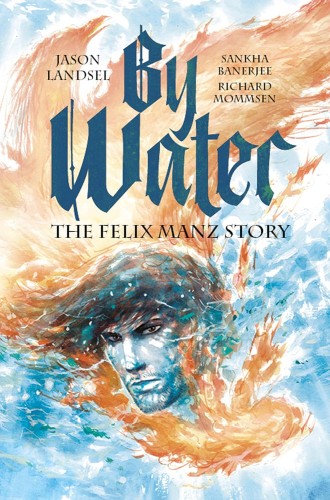Retelling a radical reformer’s story
Like Felix Manz himself, Jason Landsel’s graphic novel about him refuses to compromise its integrity to find an audience.

By Water
The Felix Manz Story
In the culminating moment of the film Contact (1997), Ellie Arroway (played by Jodi Foster), having been selected as a representative of humanity to make first contact with alien life, finds herself viewing a celestial event as she travels through space. Trying to elaborate on the sight, in awe she stammers, “No words to describe it. Poetry! They should have sent a poet. So beautiful.”
These words describe my own feelings about reviewing By Water, which offers an account of the life of Felix Manz. Manz was a 16th-century reformer in Zurich whose advocacy for believer’s baptism led to his (intentionally ironic) execution by drowning at the hands of his former mentor, Huldrych Zwingli. The subject matter falls within my specialty as a historian of early modern Europe, but unlike most biographies that line my shelves, this is a graphic novel—and here, I am in uncharted seas. By Water is a work driven by its art, and it is impossible to speak with any seriousness about the book as a biographical project without addressing the art as the primary medium. While the authors retell the story of Manz’s life with faithful adherence to detail, much of that historic detail may escape attention on a first pass due to how it is layered into the art itself.
Read our latest issue or browse back issues.
From manuscript illuminations to woodcuts and portraiture, many of the images and scenes that grace By Water are drawn from real pieces from the 16th century. These details can be found even in the panel backgrounds of several pages. Some of the historical images are reproduced in the book’s appendix, along with a timeline and several translations of important primary sources from the period, such as the Twelve Articles of the German peasants and a hymn by Manz. But still, much will be missed without a prior familiarity with the period and its history.
For example, a beautiful, full-page illustration of frogs climbing a willow tree will seem odd without knowing it is the printer’s device of Christoph Froschauer, an organizer of the Affair of the Sausages, who is referenced only by first name in a subsequent page. Another full-page illustration is a delightful reproduction of the image of a fox preaching to fowl from a 14th-century manuscript known as “The Maastricht Hours.” However, there is no citation to tell the reader this, meaning that the significance of the image and its historical reference will be lost on anyone without a thorough education in the history of the period. While there is a helpful bibliography in the appendix, there is no way for the reader to connect the information presented with the sources provided. Without the willingness and means to do some significant research, much of what shines in By Water will simply float by.
These disconnects point to my chief criticism of By Water. As evidenced by the details put into the art and the copious historical appendixes, the authors want to draw readers deeper into the life of Felix Manz and the history of the Anabaptist movement. And yet, the way they handle historical material has the effect of gatekeeping, barring those without a strong knowledge of the period from much of its richness. I found By Water to be a delight. But I had to do research to uncover many of the Easter eggs hidden in its pages, and I was left with serious doubts over whether someone without a passion for the period and a knack for independent research would find the work as compelling.
It is clear that By Water is a true passion project. At the beginning, Jason Landsel introduces his own personal and communal connections to the story of Manz’s life, and his love for the subject matter drips from every page. It also colors the telling of the story. The feelings of betrayal by Manz and his compatriots are fully fleshed out, while the rationale behind Zwingli’s change from mentor to persecutor is not, giving it the air of a heel turn. It is by no means wrong for an author to have a strong personal motive for writing on a subject, but By Water goes a step beyond biography. It is not merely the story of Manz’s life; it is the story of what the author wants the story to mean to us.
In terms of genre, then, By Water belongs in the tradition of John Foxe’s Book of Martyrs, a hagiography of the founders of the Anabaptist movement. In the 21st century, a graphic novel is definitely the way to go, and the publisher identifies this volume as the first in a series of such renderings of the lives of Anabaptists. Are we witnessing the advent of something akin to the Mennonite Cinematic Universe? As much as that would delight me, the prospects are unlikely. While By Water is a phenomenal opening to such a series, my concerns about accessibility and the way the genre of a graphic novel obscures much of the detail leave me concerned that the project will struggle to find an audience that justifies its continuation.
But is an audience what By Water wants? I’m sure it would welcome one, but not at the expense of its integrity as a project, I think, and in this the book’s faithfulness to the life of Felix Manz is on full display. While Manz and his co-reformers hoped their message would be received by others, their commitment to the project of reform did not rest on their success as measured by any human standard—and this includes the bottom lines of publishers. The passion that drove them to martyrdom was the message itself, and one of their criticisms of Zwingli and other magisterial reformers was that their willingness to work with and through the powers that be amounted to a realpolitik that compromised the integrity of the gospel. And compromise is not what leads to a work like By Water.
My hope is that this series continues, and that as it does, its authors find a way to better present their passion for this message to the uninitiated more effectively than either By Water or Manz himself was able to do. There is certainly promise here, and I will be eager to see where this river goes.





